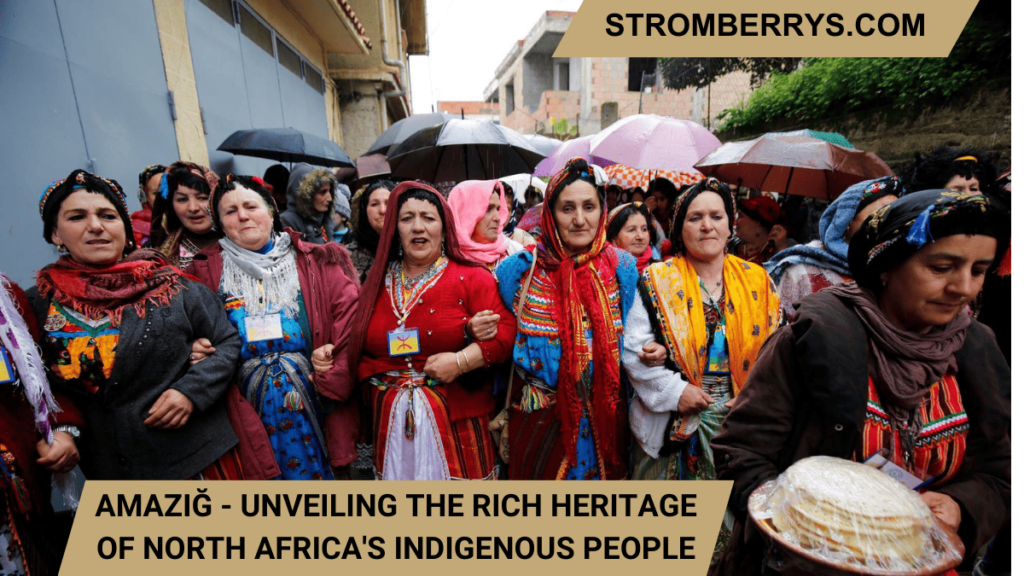Amaziğ, also known as Berbers, are the indigenous ethnic group native to North Africa, primarily concentrated in countries such as Morocco, Algeria, Tunisia, Libya, and parts of Egypt and Mauritania. This article endeavors to delve into the multifaceted world of the Amaziğ people, exploring their profound history, vibrant culture, linguistic diversity, and contemporary challenges.
Historical Background:
Ancient Roots and Civilization Interactions:
The Amaziğ people boast a history that spans millennia, with evidence of their presence in North Africa dating back to ancient times. They have weathered the tides of conquests, migrations, and cultural exchanges, interacting with civilizations such as the Phoenicians, Romans, Vandals, and Arabs.

Despite these influences, the Amaziğ have tenaciously preserved their distinct cultural identity, marked by resilience and adaptation.
Language and Culture:
A Linguistic Tapestry:
At the heart of Amaziğ identity lies their language, Tamaziɣt, which belongs to the Afro-Asiatic language family. Tamaziɣt encompasses a spectrum of dialects, each reflecting regional nuances and historical influences. Alongside language, Amaziğ culture flourishes with a kaleidoscope of traditions, including music, dance, cuisine, crafts, and oral literature. These cultural expressions serve as pillars of Amaziğ heritage, weaving a tapestry of identity that resonates through generations. The traditional music of the Amaziğ, characterized by instruments like the “ghayta” and “bendir,” and dances such as “ahwash” and “ahidous,” are celebrated aspects of their cultural life.
Geographic Distribution:
Diverse Landscapes and Shared Kinship:
The Amaziğ people are dispersed across a vast geographical expanse, with significant populations nestled in the rugged terrain of the Atlas Mountains, the verdant valleys of the Rif, and the coastal plains of Kabylie, among other regions. Despite geographic diversity, shared bonds of kinship, language, and tradition unite Amaziğ communities, fostering a sense of collective belonging rooted in ancestral lands. This geographic diversity has led to the development of various sub-groups, each with distinct dialects and cultural practices, such as the Tuareg in the Sahara and the Kabyles in Algeria.
also read: Introduntion to USPSFCL – A Comprehensive Guide
Traditional Lifestyle and Practices:
Harmony with Nature and Community Bonds:
Historically, the Amaziğ people have embraced a lifestyle intricately intertwined with the rhythms of nature, characterized by agriculture, pastoralism, and trade. They have developed ingenious farming techniques, such as terraced agriculture and qanat irrigation systems, attuned to the demands of arid landscapes.

Additionally, communal values of solidarity, hospitality, and mutual aid form the bedrock of Amaziğ social cohesion, shaping everyday interactions and communal decision-making processes.
Impact of Modernization:
Challenges and Adaptation in a Changing World:
In the face of modernization and globalization, Amaziğ communities grapple with the complexities of rapid societal transformations. Urbanization, industrialization, and mass media exert profound influences on traditional ways of life, reshaping cultural norms and societal dynamics. Moreover, socioeconomic disparities, political marginalization, and linguistic assimilation pose formidable challenges to Amaziğ identity and autonomy in the contemporary landscape.
Amaziğ Identity and Activism:
Resilience and Advocacy for Rights:
Despite these challenges, Amaziğ identity perseveres as a beacon of cultural resilience and resistance. Grassroots movements and civil society organizations advocate tirelessly for the recognition of Amaziğ rights, language revitalization efforts, and inclusive development policies. Through activism, education, and cultural revival initiatives, Amaziğ communities reclaim agency over their narrative and assert their rightful place in the mosaic of North African societies.
Contemporary Issues and Challenges:
Navigating Complexities and Striving for Equity:
Contemporary Amaziğ communities confront a myriad of challenges, including discrimination, socioeconomic marginalization, and environmental degradation. Persistent inequalities in access to education, healthcare, and employment perpetuate cycles of poverty and exclusion, exacerbating social tensions and intergenerational disparities.
also read: Blisterata – Understanding, Management, and Treatment
Furthermore, resource extraction projects, land encroachments, and climate change threaten the ecological balance of Amaziğ homelands, jeopardizing both livelihoods and cultural heritage.
Preservation Efforts:
Safeguarding Heritage and Promoting Resilience:
In response to these challenges, concerted efforts are underway to safeguard and celebrate Amaziğ culture, language, and heritage. Cultural revitalization projects, language documentation initiatives, and community-based conservation programs empower Amaziğ youth and elders alike to reclaim and transmit traditional knowledge and practices.

Additionally, legal recognition of linguistic rights, cultural diversity, and indigenous land tenure rights represents crucial milestones in the ongoing struggle for Amaziğ cultural survival and resilience.
Conclusion:
Amaziğ heritage stands as a testament to the enduring vitality of North Africa’s indigenous peoples, weaving a rich tapestry of history, culture, and resilience. As custodians of a diverse and ancient legacy, Amaziğ communities embody the spirit of cultural continuity and adaptation, navigating the complexities of modernity while honoring the wisdom of their ancestors. Through collective action and solidarity, Amaziğ people forge pathways towards a future where their identity, language, and aspirations thrive, enriching the tapestry of human diversity and belonging.
FAQs:
Who are the Amaziğ people?
The Amaziğ people, also known as Berbers, are the indigenous ethnic group native to North Africa, primarily concentrated in countries such as Morocco, Algeria, Tunisia, Libya, and parts of Egypt and Mauritania. They have a rich history, vibrant culture, and diverse linguistic heritage.
What is Tamaziɣt?
Tamaziɣt is the language spoken by the Amaziğ people. It belongs to the Afro-Asiatic language family and encompasses a spectrum of dialects, each with its own regional variations and historical influences.
What are some key aspects of Amaziğ culture?
Amaziğ culture is characterized by a rich tapestry of traditions, including music, dance, cuisine, crafts, and oral literature. Traditional practices such as communal farming, pastoralism, and mutual aid reflect the close relationship between Amaziğ communities and their environment.
What are some contemporary challenges facing Amaziğ communities?
Amaziğ communities face challenges such as discrimination, socioeconomic marginalization, and environmental degradation. Persistent inequalities in access to education, healthcare, and employment, as well as threats to land rights and cultural heritage, pose significant obstacles to Amaziğ identity and autonomy.

